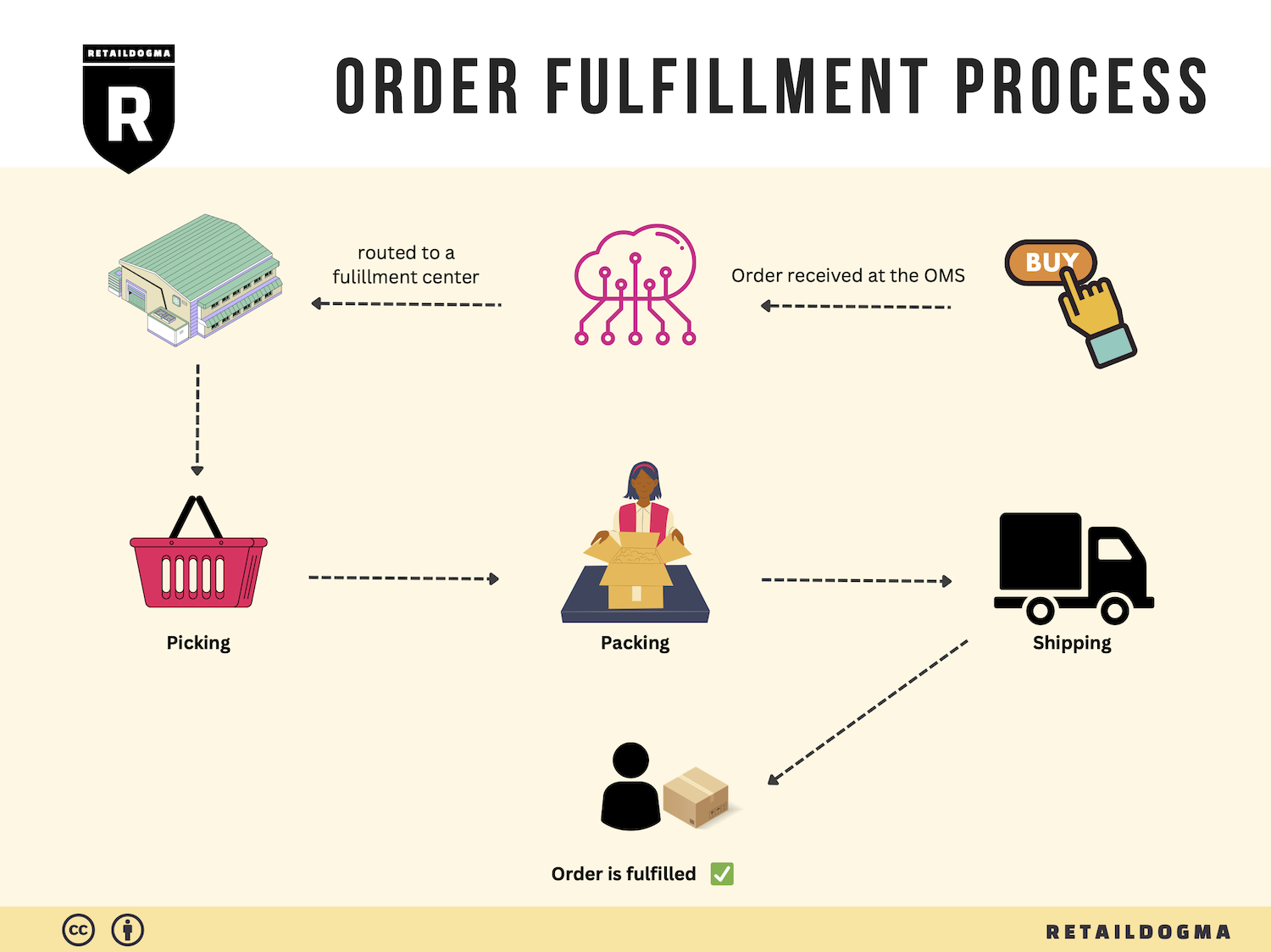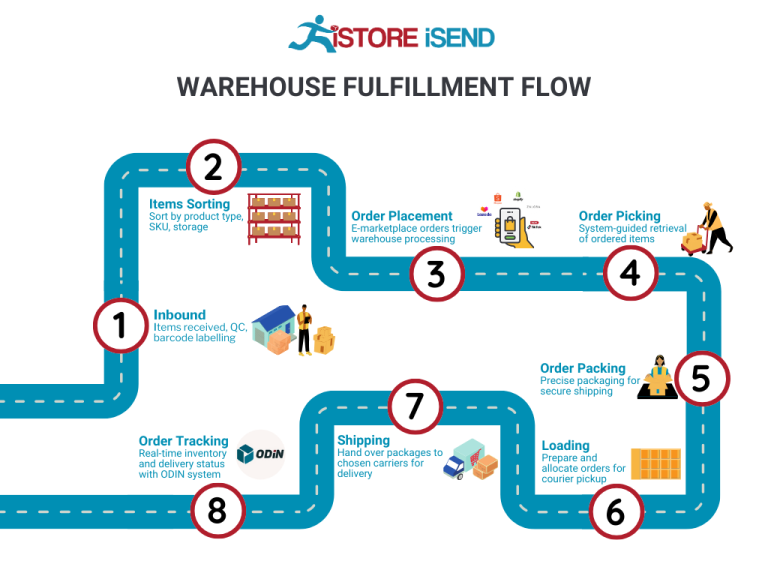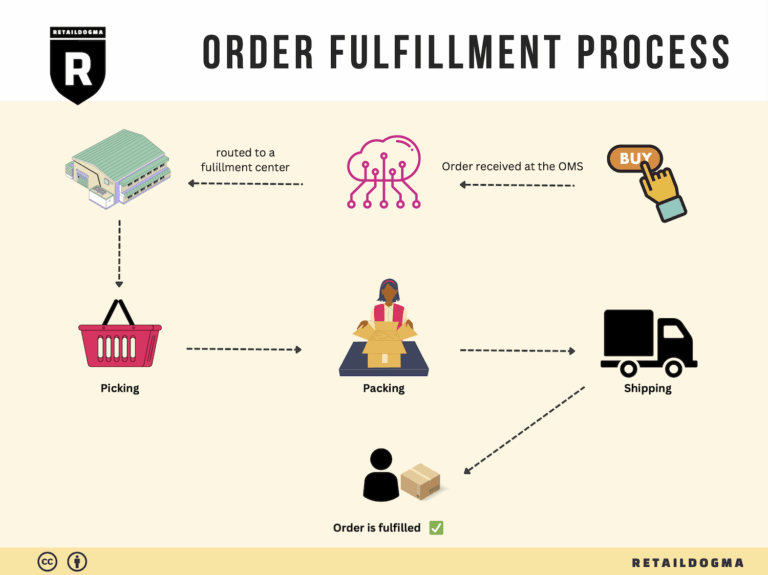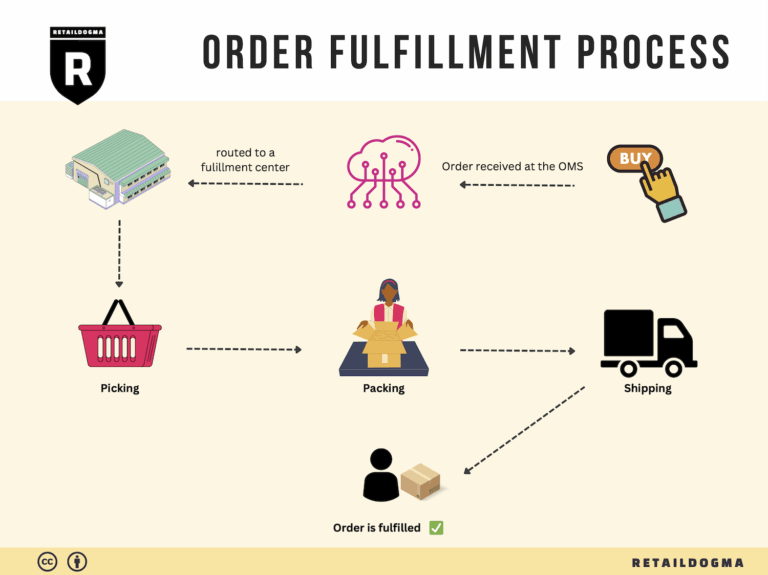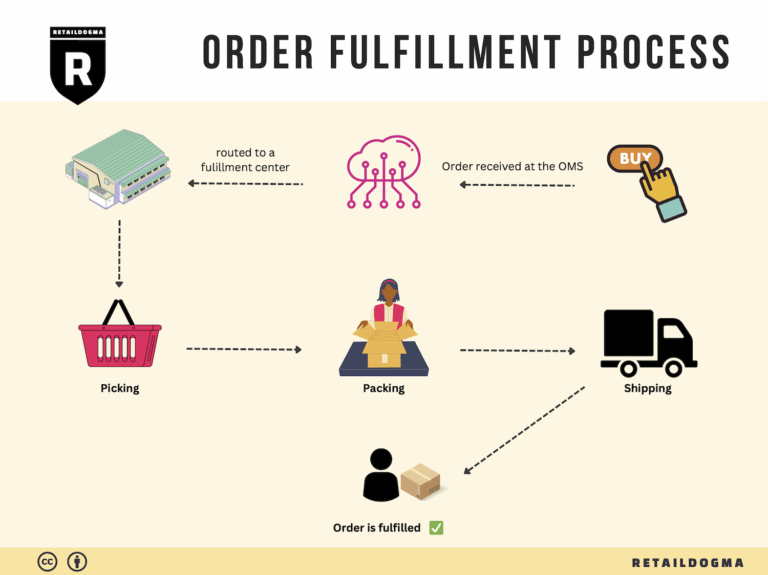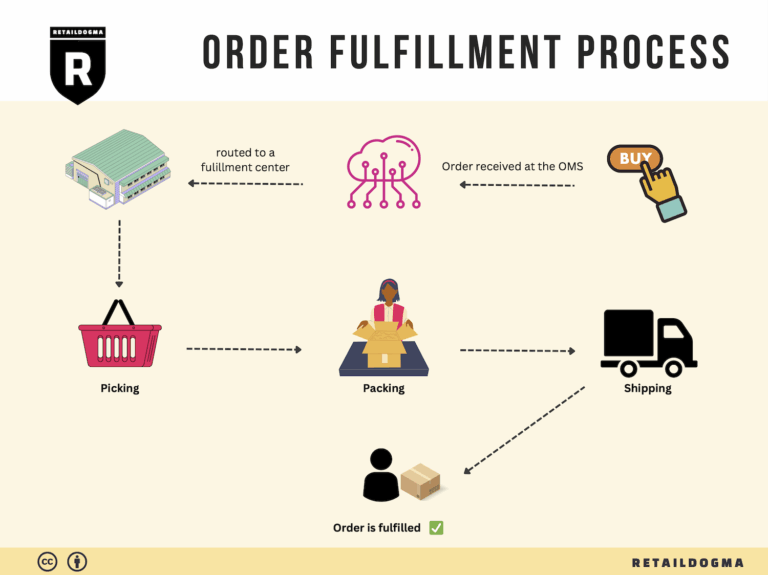Ecommerce Fulfillment Services: The Ultimate Guide (2025)
What is E-commerce Fulfillment? An Introduction for Growing Businesses
Understanding E-commerce Fulfillment: A Path to Growth
As an e-commerce business owner, you may find yourself grappling with the complexities of packing and shipping orders. The thrill of making sales can quickly turn into overwhelm when faced with the logistics of getting products to customers. This challenge is common among growing online businesses, where the demand for efficient order fulfillment often outpaces available resources.
E-commerce fulfillment is simply the process of getting a product from your warehouse to your customer’s doorstep. It encompasses everything from inventory management to picking, packing, and shipping orders. For many small to medium-sized enterprises, managing these operations in-house can become a drain on time, energy, and finances. This is where partnering with a fulfillment service can be transformative.
In this guide, we will explore various fulfillment models that can support your growing business, including Third-Party Logistics (3PL) and Fulfillment by Amazon (FBA). Each model has its own advantages and can be tailored to fit your specific needs. Understanding these options is crucial for making informed decisions about your logistics strategy.
We will also delve into the core services provided by fulfillment partners. These typically include warehousing, inventory management, order processing, and shipping. Additionally, we will discuss how to evaluate and select the right fulfillment partner. Key factors to consider include the provider’s integration capabilities with your existing e-commerce platforms, their pricing structure, and their ability to scale with your business as demand fluctuates.
Pricing is another critical element we will address. Understanding the cost implications of different fulfillment options will empower you to choose a solution that aligns with your budget and growth objectives.
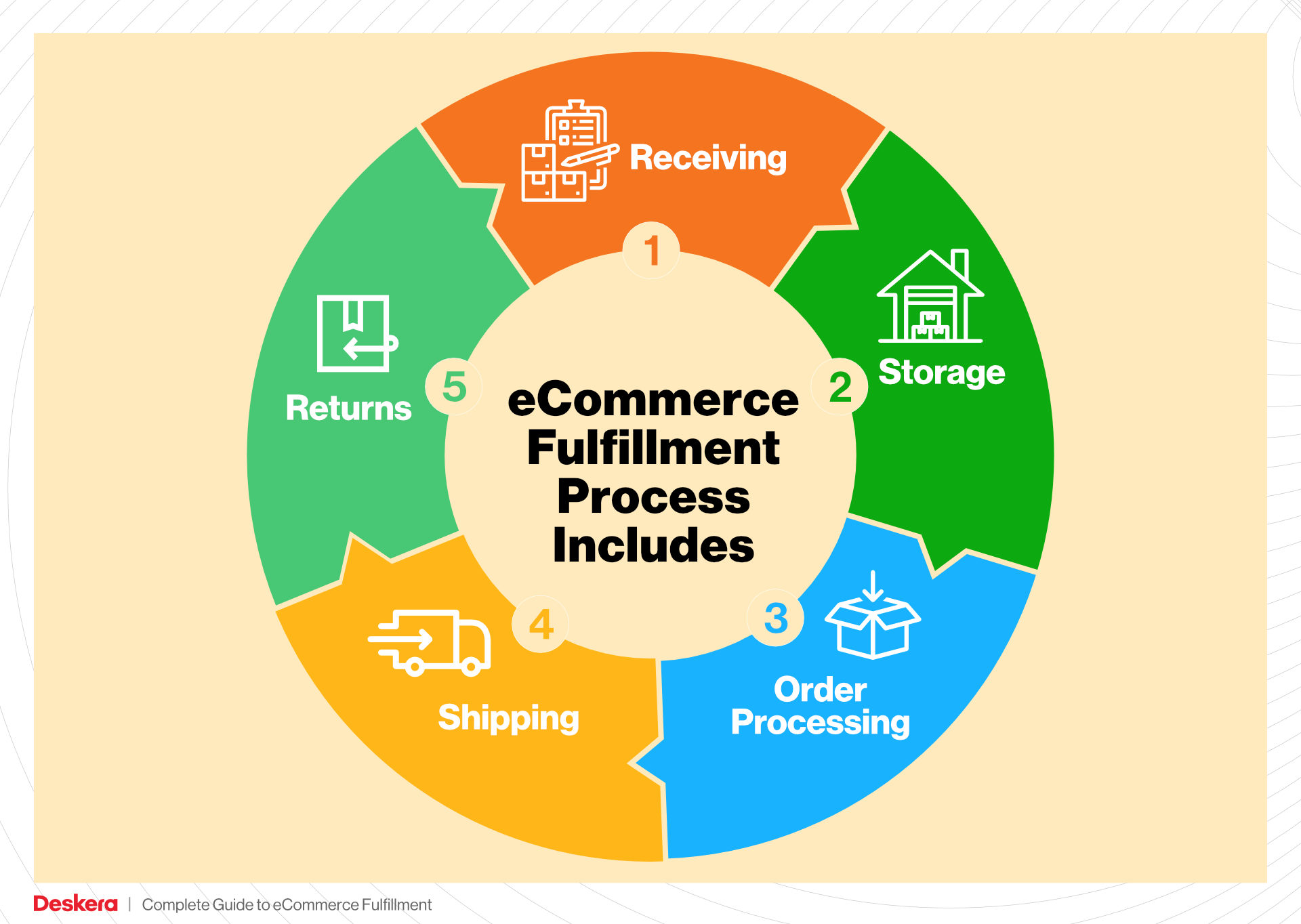
Our goal with this guide is to equip you with the knowledge necessary to navigate the complexities of e-commerce fulfillment confidently. By making informed decisions about your logistics, you can focus on what you do best—growing your business and delighting your customers. Whether you’re just starting out or looking to scale, this guide will serve as a valuable resource in streamlining your fulfillment processes and enhancing your overall operational efficiency.
What You’ll Learn In This Guide
- What is E-commerce Fulfillment? An Introduction for Growing Businesses
- The Order Fulfillment Process: From ‘Buy’ Button to Customer’s Door
- Comparing Fulfillment Models: In-House vs. 3PL vs. Dropshipping
- A Deep Dive into Amazon FBA: Pros, Cons, and Who It’s For
- Core Services Offered by Fulfillment Centers
- How to Choose a Fulfillment Partner: A 6-Point Checklist
- Understanding Fulfillment Pricing: A Breakdown of Common Fees
- Frequently Asked Questions (FAQs) about Fulfillment
- Conclusion: Is Outsourcing Fulfillment the Right Move for Your Business?
- Important Disclaimer
The Order Fulfillment Process: From ‘Buy’ Button to Customer’s Door
1. Receiving Inventory
The first step in the order fulfillment process is receiving inventory. This involves taking delivery of products from suppliers and checking them against purchase orders to ensure accuracy. When inventory arrives at the fulfillment center, it is important to verify that the quantity and condition match what was ordered. This is where the use of Stock Keeping Units (SKUs) comes into play. Each product is assigned a unique SKU, which helps streamline the receiving process by allowing staff to quickly identify items.
Accurate receiving is crucial because it sets the foundation for the entire fulfillment process. Any discrepancies at this stage can lead to inventory inaccuracies, affecting order fulfillment down the line. Additionally, proper documentation and inventory tracking systems are essential to maintain real-time visibility of stock levels. This ensures that businesses can manage their inventory effectively, avoiding stockouts or overstock situations that can negatively impact cash flow.
2. Warehouse Storage
Once the inventory has been received and verified, the next step is warehouse storage. Products are organized and stored in designated locations within the warehouse. Efficient warehouse layout and storage systems play a vital role in optimizing the fulfillment process. Businesses often utilize techniques such as zone storage, where products are stored based on their sales velocity, or ABC analysis, which categorizes items based on their importance and demand.
Effective storage not only maximizes space but also enhances the speed of order picking later in the process. By strategically placing high-demand items closer to the packing area, fulfillment centers can significantly reduce picking times. Proper organization and labeling of storage locations are key to minimizing errors during the picking process, ensuring that orders are fulfilled accurately and promptly.
3. Order Picking
Order picking is the process of retrieving items from storage to fulfill customer orders. When an order is placed, a pick list is generated, detailing the products and their respective locations in the warehouse. This document guides warehouse staff in efficiently gathering the required items. Depending on the order volume and warehouse layout, businesses may employ various picking methods, such as single order picking, batch picking, or wave picking.
This step is critical because it directly impacts order accuracy and fulfillment speed. Errors during picking can lead to customer dissatisfaction, returns, and increased operational costs. Therefore, implementing technology such as barcode scanning or automated picking systems can greatly enhance accuracy and efficiency. By ensuring that the correct items are picked in a timely manner, businesses can improve their overall customer experience and maintain a competitive edge.
4. Order Packing
Once the items have been picked, they move on to the packing stage. During this phase, products are carefully packed into boxes or envelopes, ensuring they are secure and protected for transit. This is where professional packaging design comes into play, as it not only protects the items but also enhances the brand experience for the customer. The packaging should reflect the brand’s identity and include necessary documentation, such as invoices or return labels.

Packing is vital because it ensures that products arrive at their destination in perfect condition. Proper packing techniques can prevent damage during shipping, which can result in costly returns and replacements. Additionally, efficient packing processes can help optimize shipping costs by minimizing dimensional weight. By focusing on high-quality packing, businesses can improve customer satisfaction and reduce the risk of returns, ultimately contributing to a positive brand reputation.
5. Shipping & Delivery
The final step in the order fulfillment process is shipping and delivery. Once the order is packed, it is handed over to a shipping carrier for delivery to the customer’s address. This stage involves selecting the best shipping method based on factors such as delivery speed, cost, and customer preferences. Tracking information is typically generated at this point, allowing customers to monitor their orders in real-time.
Shipping and delivery are critical components of the customer experience. Fast and reliable delivery can set a business apart from its competitors, while delays or issues can lead to dissatisfaction and lost sales. By leveraging partnerships with multiple carriers and utilizing advanced shipping software, businesses can optimize their shipping strategies, ensuring that orders are delivered promptly and efficiently. Ultimately, a streamlined shipping process enhances customer loyalty and can lead to repeat business, which is essential for scaling e-commerce operations.
Comparing Fulfillment Models: In-House vs. 3PL vs. Dropshipping
Fulfillment Model Comparison
| Model | Who Handles Inventory | Best For (Business Stage) | Key Advantage | Key Disadvantage |
|---|---|---|---|---|
| In-House Fulfillment | The business itself | Established businesses | Complete control over inventory and processes | High overhead costs and resource demands |
| Third-Party Logistics (3PL) | 3PL provider | Growing to scaling businesses | Cost-effective and scalable logistics | Less control over inventory and processes |
| Dropshipping | Supplier or manufacturer | Startups and small businesses | Low upfront investment and inventory risk | Lower profit margins and potential quality control issues |
In-House Fulfillment
In-house fulfillment involves a business managing its entire inventory and logistics process independently. This model is often favored by established businesses with sufficient resources, as it allows for complete control over every aspect of the fulfillment process. From warehousing to packing and shipping, businesses can tailor their operations to meet specific customer needs. However, maintaining an in-house fulfillment system comes with significant overhead costs, including expenses related to warehouse space, equipment, and labor. Additionally, the demand for rapid order processing can strain resources, especially during peak seasons. For businesses that prioritize quality control and brand consistency, in-house fulfillment can be advantageous, but it also requires a significant commitment of time, capital, and operational focus.
Third-Party Logistics (3PL)
Third-party logistics (3PL) providers, such as Selery Fulfillment, offer a comprehensive range of services that encompass storage, order fulfillment, and shipping. This model is ideal for businesses that are in a growth phase or are looking to scale operations without the burden of managing logistics themselves. By outsourcing fulfillment to a 3PL, businesses can benefit from competitive pricing, faster shipping times, and access to advanced logistics technologies. 3PL providers often have established relationships with carriers, which can lead to lower shipping costs. However, a key disadvantage is that businesses may have less direct control over their inventory and fulfillment processes, which can impact customer experience if not managed properly. Effective communication and integration with the 3PL provider are crucial to ensure that operational goals align and that customer expectations are met.
Dropshipping
Dropshipping is a fulfillment model where retailers sell products without holding inventory. Instead, when an order is placed, the retailer purchases the item from a third-party supplier, who then ships it directly to the customer. This model is particularly appealing to startups and small businesses due to its low upfront investment and minimal financial risk. Retailers can offer a wide range of products without the need for warehousing or inventory management. However, dropshipping comes with its own set of challenges. Profit margins can be significantly lower, as retailers often rely on suppliers for pricing. Additionally, quality control can be an issue, as retailers have little oversight over the products being shipped. Shipping times may also be longer, which can lead to customer dissatisfaction. Overall, while dropshipping can facilitate rapid entry into the e-commerce space, businesses must carefully choose suppliers and manage customer expectations to succeed.
Conclusion
Selecting the right fulfillment model is crucial for the success of an e-commerce business. Each model—In-House Fulfillment, 3PL, and Dropshipping—offers unique advantages and disadvantages that cater to different business stages and operational needs. By understanding these differences, e-commerce business owners can make informed decisions that align with their growth strategies and customer service goals. For many, partnering with a 3PL provider like Selery Fulfillment can provide a balanced approach, allowing businesses to scale while minimizing the distractions of logistics management.
A Deep Dive into Amazon FBA: Pros, Cons, and Who It’s For
Understanding Fulfillment by Amazon (FBA)
Fulfillment by Amazon (FBA) is a service provided by Amazon that allows sellers to store their products in Amazon’s fulfillment centers. Amazon then takes care of storage, packaging, shipping, and customer service on behalf of the sellers. This service enables e-commerce businesses to leverage Amazon’s vast logistics network, making it a popular choice among online retailers.
How FBA Works
-
Setting Up FBA: Sellers first create an Amazon seller account and list their products on the platform. They then select which products they want to fulfill through FBA and prepare them according to Amazon’s guidelines.
-
Shipping Products to Amazon: Once products are ready, sellers send them in bulk to Amazon’s fulfillment centers. Amazon provides guidelines on how to package and label items to ensure they are processed efficiently.
-
Storage: Products are stored in Amazon’s warehouses until an order is placed. Amazon uses advanced inventory management systems to track and manage stock levels.
-
Order Fulfillment: When a customer places an order for a product, Amazon picks, packs, and ships the item directly to the customer. This process is streamlined, often allowing for same-day or next-day delivery, especially for Amazon Prime members.
-
Customer Service and Returns: Amazon handles all customer service inquiries related to FBA products, including returns and refunds, which relieves sellers of these responsibilities.
Pros of Using FBA
-
Prime Eligibility: One of the significant advantages of using FBA is that products become eligible for Amazon Prime. This can significantly enhance visibility and sales, as Prime members tend to prefer items that qualify for faster shipping.
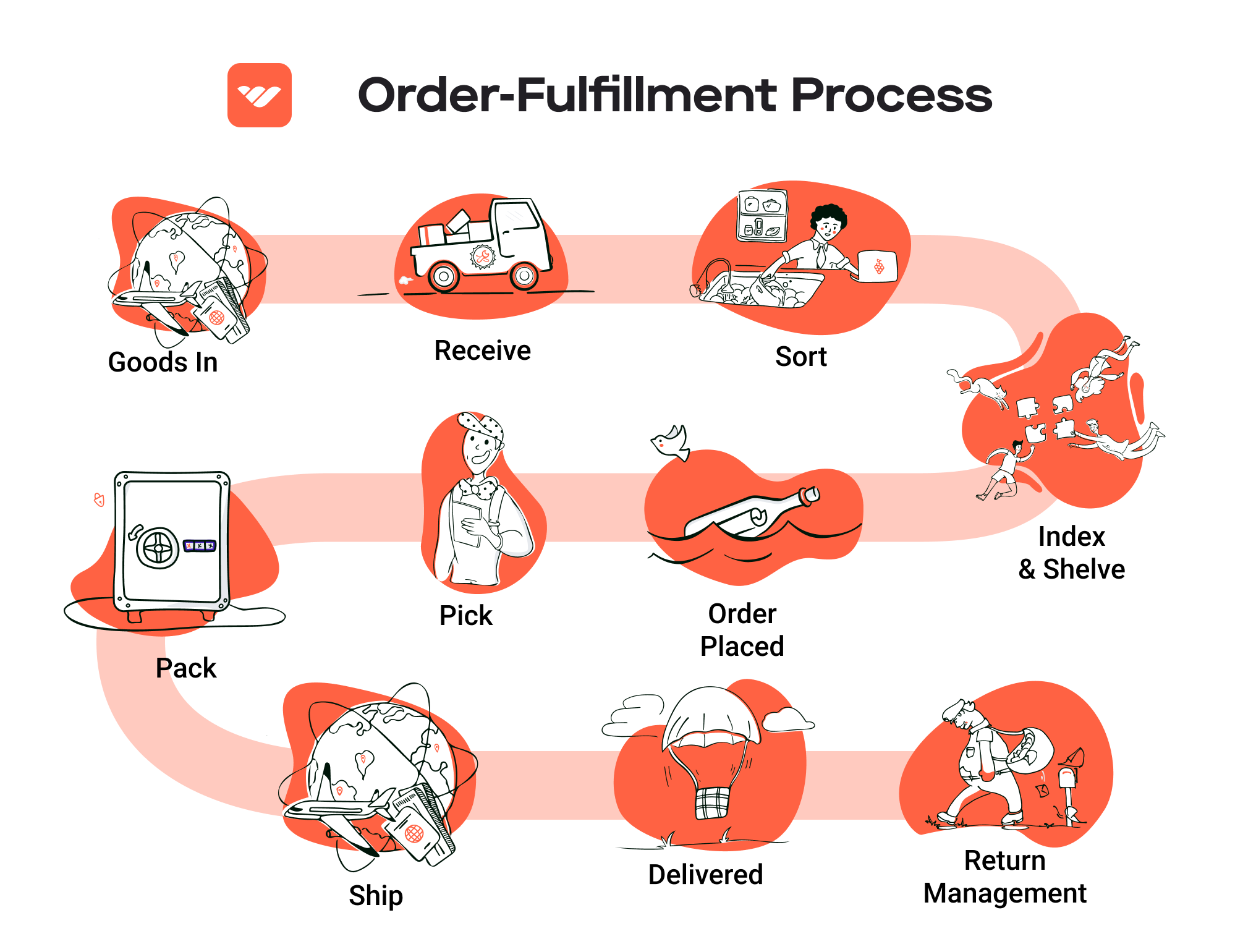
-
Customer Trust: Amazon is a trusted name in e-commerce. By utilizing FBA, sellers can benefit from the credibility associated with the Amazon brand. Customers often feel more secure purchasing from sellers using FBA due to Amazon’s reliable shipping and customer service.
-
Multi-Channel Fulfillment: FBA isn’t limited to Amazon sales. Sellers can use FBA to fulfill orders from their own websites and other platforms, allowing for a unified inventory and streamlined shipping processes.
-
Scalability: FBA allows businesses to scale without the need to invest in warehousing and logistics infrastructure. Sellers can focus on product development and marketing while Amazon manages the fulfillment process.
-
Advanced Logistics: Amazon’s sophisticated logistics network ensures quick and efficient delivery, which can lead to higher customer satisfaction and repeat purchases.
Cons of Using FBA
-
High Fees: FBA charges various fees, including storage fees for items stored in their warehouses and fulfillment fees for each order shipped. These costs can add up, especially for sellers with low-margin products or those with excess inventory.
-
Strict Inventory Rules: Amazon has stringent policies regarding inventory management. Sellers must adhere to guidelines for storage limits, labeling, and packaging, which can be cumbersome and time-consuming.
-
Commingling Risks: FBA products may be commingled with inventory from other sellers, meaning that a seller’s products could be shipped to customers alongside items from different sellers. This raises concerns about quality control and brand consistency.
-
Loss of Control: By outsourcing fulfillment to Amazon, sellers relinquish some control over the shipping and customer service processes. Any issues that arise can reflect poorly on the seller, even if they are due to Amazon’s handling.
-
Complex Returns Process: While Amazon manages returns, the process can sometimes be complex. Sellers might face challenges with returned items, including lost inventory or items returned in unsellable condition.
Who is FBA Best For?
Fulfillment by Amazon is particularly suited for:
-
Small to Medium-Sized Businesses: Businesses looking to expand their reach without significant investment in logistics and warehousing can benefit from FBA’s infrastructure.
-
E-commerce Startups: New entrepreneurs can leverage FBA to gain visibility and credibility in a competitive marketplace without the burden of managing fulfillment logistics.
-
Sellers with High Volume Sales: Businesses with a high turnover of products can take advantage of Amazon’s efficient logistics to scale their operations rapidly.
-
Brands Seeking to Enhance Their Reach: Brands aiming to tap into Amazon’s vast customer base and benefit from Prime membership can find FBA an attractive option.
-
Multi-Channel Sellers: Businesses that sell across various platforms can streamline their operations by using FBA for all their fulfillment needs.
In conclusion, Fulfillment by Amazon can be a powerful tool for e-commerce businesses looking to scale efficiently. However, it is essential for sellers to weigh the pros and cons carefully, considering their business model, product types, and long-term goals before committing to this fulfillment method.
Core Services Offered by Fulfillment Centers
Inventory Management & Warehousing
Inventory management and warehousing are foundational services provided by fulfillment centers, designed to streamline the storage and organization of products for e-commerce businesses. This service involves the systematic tracking of inventory levels, orders, sales, and deliveries, ensuring that businesses have real-time visibility into their stock. Fulfillment centers utilize sophisticated inventory management systems that monitor stock levels, helping businesses avoid overstocking or stockouts.
Benefits:
1. Optimized Space Utilization: Fulfillment centers are equipped with advanced storage solutions that maximize space efficiency, allowing businesses to store a greater variety of products without the need for additional warehouse space.
2. Real-Time Tracking: With integrated inventory management software, businesses can track inventory levels in real-time, enabling better forecasting and demand planning.
3. Reduced Overhead Costs: By outsourcing warehousing, e-commerce businesses can save on the significant costs associated with leasing, maintaining, and staffing a warehouse.
4. Scalability: As your business grows, fulfillment centers can easily accommodate increased inventory levels, allowing for seamless scaling without the need for major logistical changes.
Pick and Pack Services
Pick and pack services are a critical function of fulfillment centers, where ordered items are selected (picked) from inventory and then packaged (packed) for shipping to customers. This process is essential for ensuring that orders are fulfilled accurately and efficiently.
Benefits:
1. Speed and Accuracy: Fulfillment centers are equipped with efficient picking systems that streamline order processing, resulting in faster turnaround times and reduced errors.
2. Quality Control: Many fulfillment centers incorporate quality checks during the pick and pack process, ensuring that the right products are shipped in excellent condition.
3. Custom Packaging Options: Fulfillment centers often provide custom packaging solutions that enhance brand presentation and improve the unboxing experience for customers, which can lead to increased customer satisfaction and loyalty.
4. Focus on Core Business Activities: By outsourcing the pick and pack process, e-commerce businesses can concentrate on product development, marketing, and customer engagement, rather than getting bogged down in logistics.
Kitting and Assembly
Kitting and assembly services involve the grouping of multiple products into a single package or the assembly of components into a finished product. This service is particularly valuable for businesses that offer bundled products or require assembly before shipping.
Benefits:
1. Enhanced Product Offerings: Kitting allows e-commerce businesses to create attractive product bundles, which can increase average order value and enhance the shopping experience.
2. Streamlined Assembly Processes: By outsourcing assembly to fulfillment centers, businesses can reduce the time and labor costs associated with in-house assembly, leading to greater operational efficiency.
3. Flexibility: Fulfillment centers can adapt to various kitting requirements, whether it’s seasonal promotions, special events, or new product launches, providing e-commerce businesses with the agility to respond to market demands.
4. Improved Inventory Management: Kitting can help manage inventory more effectively by reducing the number of individual SKU items, simplifying stock management and replenishment processes.
Returns Management (Reverse Logistics)
Returns management, also known as reverse logistics, is a vital service provided by fulfillment centers that handles the processing of returned items. Efficient returns management is crucial for maintaining customer satisfaction and loyalty in e-commerce.
Benefits:
1. Streamlined Process: Fulfillment centers have established procedures for handling returns, making it easier for businesses to manage the influx of returned items without disrupting their operations.
2. Customer Satisfaction: A hassle-free returns process enhances the customer experience, encouraging repeat purchases and positive reviews, which are essential for building brand loyalty.
3. Inventory Recovery: Effective returns management allows businesses to quickly assess returned products and reintegrate them into inventory, minimizing loss and maximizing potential resale.
4. Data Insights: Fulfillment centers can provide valuable data on return reasons and trends, enabling businesses to make informed decisions about product quality, customer preferences, and inventory management strategies.
In conclusion, partnering with a fulfillment center offers e-commerce businesses a comprehensive suite of services that enhance operational efficiency, reduce costs, and improve customer satisfaction. By outsourcing these core functions, businesses can focus on their growth and core competencies, ultimately leading to sustained success in the competitive e-commerce landscape.
How to Choose a Fulfillment Partner: A 6-Point Checklist
Location & Warehouse Network
Importance: The location of your fulfillment partner’s warehouses can significantly affect shipping times and costs. A partner with strategically placed facilities can help you reach your customers faster and reduce shipping expenses.
Questions to Ask:
– Where are your warehouses located, and how many do you operate?
– How do you determine which warehouse will fulfill my orders?
– Can you accommodate international shipping, and if so, what locations do you serve?
– How does your warehouse network support same-day shipping?
Technology & Integrations
Importance: A robust technology platform is essential for seamless order management, inventory tracking, and integration with your existing e-commerce systems. Efficient technology can streamline operations and provide real-time insights into your business.
Questions to Ask:
– What technology do you use for order management, inventory tracking, and reporting?
– Can your system integrate with my current e-commerce platform (e.g., Shopify, Amazon, eBay)?
– How do you handle inventory synchronization between your system and mine?
– Is there a middleware solution for automating data transfers, and how does it work?
Specializations (e.g., Cold Storage, Oversized Items)
Importance: Depending on your product types, you may need specific capabilities, such as temperature-controlled storage for perishable goods or the ability to handle oversized items. Ensuring your fulfillment partner can meet these needs is crucial for maintaining product quality and customer satisfaction.
Questions to Ask:
– What types of products do you specialize in fulfilling?
– Do you have specialized storage solutions (e.g., cold storage, hazardous materials)?
– How do you ensure product integrity during storage and shipping?
– Can you handle custom packaging or kitting for specialized items?
Scalability & Capacity
Importance: As your business grows, your fulfillment needs will evolve. A good partner should have the capacity to scale operations in line with your growth, ensuring that your logistics can keep pace with sales increases without compromising service quality.
Questions to Ask:
– What is your current fulfillment capacity, and how do you manage peak seasons?
– Can you accommodate rapid growth, and if so, what is your plan for scaling operations?
– How do you handle increased order volumes during busy periods (e.g., holidays)?
– Are there any limits on the number of SKUs or inventory you can manage?
Pricing and Contracts
Importance: Understanding the pricing structure and contract terms is essential for budgeting and ensuring that your partnership remains profitable. Transparent pricing helps avoid unexpected costs that could erode margins.
Questions to Ask:
– What is your pricing model (e.g., per order, per item, monthly fees)?
– Are there any additional costs that I should be aware of (e.g., storage fees, pick and pack fees)?
– What are the terms of your contracts, and is there flexibility for renegotiation?
– Do you offer a satisfaction guarantee or trial period to evaluate your services?
Customer Support & Reviews
Importance: Reliable customer support is vital for addressing any operational issues quickly. A partner that values communication and has a track record of positive reviews can significantly enhance your fulfillment experience.
Questions to Ask:
– What level of customer support do you provide (e.g., dedicated account managers, 24/7 support)?
– How quickly can I expect responses to inquiries or issues?
– Can you provide references or case studies from similar businesses?
– What is your process for handling fulfillment errors or customer complaints?
Conclusion
Choosing the right fulfillment partner is a critical decision that can impact your e-commerce business’s success. By using this checklist, you can ensure that you thoroughly evaluate potential partners based on essential criteria that align with your business goals. Remember, the right partner will not only fulfill orders but also contribute to your overall growth and customer satisfaction. Take the time to ask these questions, gather insights, and make an informed decision that supports your business’s future.
Understanding Fulfillment Pricing: A Breakdown of Common Fees
Initial Setup Fees
When partnering with a third-party logistics (3PL) provider like Selery Fulfillment, the initial setup fee is often the first cost you encounter. This fee typically covers the administrative expenses involved in onboarding your business. It may include the integration of your e-commerce platform with the fulfillment center’s systems, configuration of inventory management software, and initial training for your team on how to use the new systems.
The calculation of initial setup fees can vary based on the complexity of your operations and the level of customization required. For instance, if you have unique packaging requirements or need specialized handling for certain products, the setup fee might be higher. Always inquire about what the setup fee includes to avoid unexpected costs down the line.
Receiving Fees
Receiving fees are charged when your inventory arrives at the fulfillment center. This fee compensates the logistics provider for the labor and resources involved in unloading, inspecting, and storing your products. The receiving process usually includes checking for damages, verifying quantities against shipping documents, and entering product information into the inventory system.
Typically, receiving fees are calculated on a per-pallet or per-item basis, depending on the provider’s pricing structure. For example, if your shipment consists of multiple pallets, you may be charged a flat rate per pallet. It’s essential to understand this fee, especially if you anticipate frequent shipments, as it can significantly impact your overall fulfillment costs.
Storage Fees (per pallet/bin)
Storage fees are recurring costs associated with keeping your inventory at the fulfillment center. These fees are usually calculated based on the volume of space your products occupy, often measured in pallets or bins. Depending on the provider, storage fees can be charged monthly or annually.
The calculation of storage fees can vary. For instance, some providers may offer tiered pricing structures where the cost per pallet decreases as you store more inventory. Additionally, seasonal fluctuations may affect storage fees; during peak seasons, you may incur higher fees due to increased demand for warehouse space. Always review the provider’s policy on storage fees and any potential discounts for long-term commitments.
Pick & Pack Fees (per item/order)
Pick and pack fees are charged for the labor involved in selecting products from storage and preparing them for shipment. This fee is typically calculated on a per-item or per-order basis. The process includes picking the correct items, packing them securely, and preparing shipping labels.
Variability in pick and pack fees can stem from several factors, such as the complexity of your products (e.g., fragile items may require additional care) or specific packaging requirements (like branded boxes). Some providers may also charge a flat fee for small orders or bulk orders, while others may implement a sliding scale. Understanding these costs is crucial for budgeting and pricing your products effectively.
Shipping Fees
Shipping fees are one of the most significant costs in the fulfillment process, as they directly affect the speed and reliability of order delivery. These fees encompass the costs associated with transporting your products from the fulfillment center to the customer. They can be influenced by various factors, including the shipping method (standard, expedited, etc.), the weight and dimensions of the package, and the delivery destination.
Shipping fees can be calculated using various methods, such as flat-rate shipping, weight-based shipping, or zone-based shipping, where costs vary depending on the delivery location. It’s vital to discuss shipping options with your fulfillment provider to ensure you select the most cost-effective and timely solutions for your business needs.
Tips for Getting an Accurate Quote
To secure a precise quote for fulfillment services, consider the following tips:
-
Provide Detailed Information: Share specifics about your products, including dimensions, weight, and handling requirements. This information helps the fulfillment provider assess storage and shipping needs accurately.
-
Inquire About All Fees: Ask about all potential fees, including hidden costs that might not be immediately apparent. Understanding the entire fee structure will help you budget more effectively.
-
Discuss Volume Discounts: If you anticipate high order volumes, inquire about bulk pricing or discounts. Many providers offer better rates for larger commitments.
-
Evaluate Integrations: Ensure that your e-commerce platform integrates seamlessly with the fulfillment provider’s system. This integration can save time and reduce errors, impacting overall costs.
-
Request a Trial Period: If possible, ask for a trial period to evaluate the provider’s services and pricing. This allows you to gauge performance before committing long-term.
By following these steps, you can ensure that you receive an accurate and comprehensive quote, enabling you to make informed decisions for your e-commerce business.
Frequently Asked Questions (FAQs) about Fulfillment
1. What is Selery Fulfillment?
Selery Fulfillment is a comprehensive third-party logistics (3PL) provider that specializes in e-commerce order fulfillment. We manage the entire process of storing, picking, packing, and shipping products purchased online, allowing business owners to focus on sales and product development while we handle logistics efficiently.
2. What is the difference between a warehouse and a fulfillment center?
A warehouse primarily focuses on storing goods, often for long periods. In contrast, a fulfillment center is designed specifically for order processing, including picking, packing, and shipping products directly to customers. Fulfillment centers are equipped to handle high volumes of orders quickly and efficiently, which is essential for e-commerce businesses.
3. What is a 3PL?
A 3PL, or third-party logistics provider, is a company that offers outsourced logistics services, including storage, fulfillment, and shipping. By partnering with a 3PL like Selery, businesses can streamline their operations, reduce overhead costs, and leverage specialized expertise in logistics management.
4. How much do fulfillment services cost?
The cost of fulfillment services varies based on several factors, including order volume, storage needs, packaging requirements, and shipping destinations. Selery Fulfillment offers competitive pricing structures tailored to your business needs. To get a precise quote, you can fill out a form on our website for a custom estimate.
5. How does Selery handle inventory management?
Selery uses advanced inventory management systems that provide real-time tracking and monitoring of stock levels across our warehouses. Our clients can access detailed inventory reports, ensuring they are always aware of their product availability and can manage their stock efficiently.
6. Can Selery Fulfillment integrate with my existing e-commerce platform?
Yes, Selery offers seamless integrations with various e-commerce platforms, including Shopify, Amazon, and eBay. Our middleware system connects your online store to our fulfillment operations, automating order processing and ensuring a smooth workflow from purchase to delivery.
7. How quickly can Selery fulfill and ship my orders?
Selery prides itself on having some of the fastest lead times in the industry. Once an order is placed, we can typically pick, pack, and ship the product on the same day from the nearest warehouse, helping you meet customer expectations for rapid delivery.
8. What types of products can Selery Fulfillment handle?
Selery Fulfillment can manage a wide variety of products, including temperature-sensitive items, subscription boxes, and more. Our facilities include climate-controlled storage areas, ensuring that we can accommodate diverse product requirements while maintaining quality.
9. What support does Selery provide to its clients?
At Selery, we believe in providing personalized support. Each client is assigned an account manager who is readily available to assist with any questions or concerns. Additionally, our team conducts regular check-ins to ensure that your fulfillment needs are being met and to address any potential issues proactively.
10. How can I get started with Selery Fulfillment?
Getting started with Selery Fulfillment is simple. First, connect your e-commerce store to our platform. Then, send us your inventory and we’ll take care of the rest, including storage, order processing, and shipping. For more details, you can contact us directly or fill out our online form to discuss your specific requirements.
Conclusion: Is Outsourcing Fulfillment the Right Move for Your Business?
The Advantages of Outsourcing Fulfillment
As you contemplate the future of your e-commerce business, consider the significant advantages that outsourcing fulfillment can provide. By partnering with a fulfillment service, you can save invaluable time that can be redirected towards strategic growth initiatives. Instead of grappling with the complexities of inventory management, order processing, and shipping logistics, you can focus on enhancing your product offerings and engaging with your customers.
Scalability is another compelling reason to consider a fulfillment partner. As your business grows, so do the demands of order fulfillment. A professional fulfillment service has the infrastructure to handle increased order volumes without compromising speed or accuracy. This scalability is crucial for capitalizing on sales spikes during peak seasons or promotional events without the need for substantial investment in your own warehousing and logistics capabilities.
Moreover, leveraging the expertise of a dedicated fulfillment provider can lead to improved efficiency and reduced costs. With specialized knowledge in logistics, packaging, and shipping, these partners can optimize your operations, ensuring timely deliveries and excellent customer experiences. This expertise is particularly valuable in navigating the complexities of multi-channel sales and integrating with platforms like Amazon and Shopify.
Choosing the Right Partner
However, it’s essential to choose the right fulfillment partner for your specific needs. A partner that understands your business model and can offer tailored solutions will be instrumental in your growth journey. Look for providers that prioritize customer service, offer transparent pricing, and have proven track records of reliability and efficiency.
Call to Action
Take proactive steps today by auditing your current shipping processes. Evaluate whether your existing logistics operations align with your growth ambitions. If you find inefficiencies or limitations, it may be time to consider a fulfillment partner. Embrace the opportunity to simplify your operations and set the stage for sustainable growth. Your next strategic move could redefine your business trajectory.
Important Disclaimer
⚠️ Important Disclaimer
The information in this guide is for educational purposes. Fulfillment services, pricing, and platform features change frequently. Always conduct your own due diligence and consult with providers directly before making business decisions.
